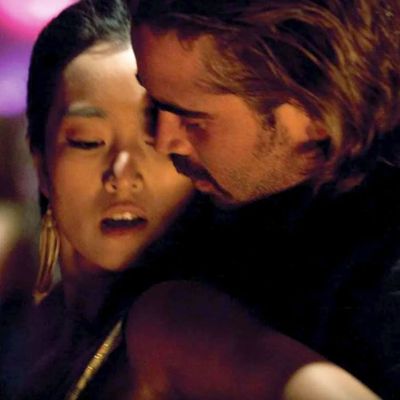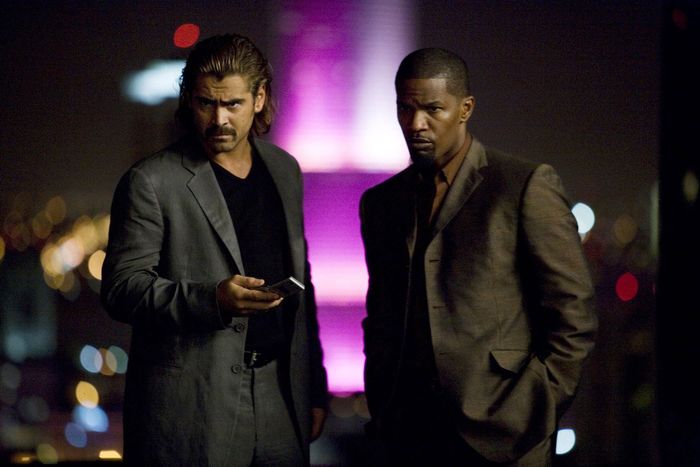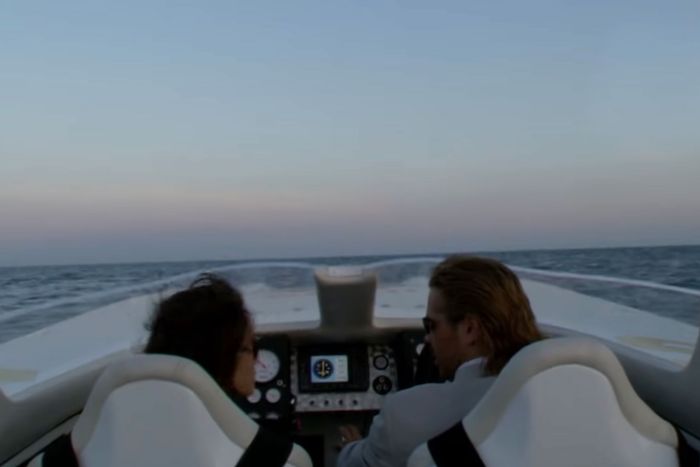
At regular but sometimes unpredictable intervals, Vulture selects a film to watch with our readers as part of our Wednesday Night Movie Club. This week’s selection comes from Vulture critic Bilge Ebiri, who will begin his screening of Miami Vice (which turns 15 this year!) on October 6 at 7 p.m. ET. Head to Vulture’s Twitter to catch his live commentary.
The damn thing just starts. Before any credits roll, without any scene setting or throat clearing, we’re already a few bars into “Numb/Encore” in a sweaty, crowded Miami club, with Sonny Crockett (Colin Farrell) and Ricardo Tubbs (Jamie Foxx) and their team about to pounce on a sex trafficker named Neptune (Isaach de Bankolé). Suddenly, amid the chaos, Crockett and Tubbs are whisked away to a phone call from a distraught informant, Alonzo Stevens (John Hawkes), who is speeding and swerving down the highway in his Bentley and wants to say a desperate goodbye to our heroes, while a sting operation involving neo-Nazis and FBI agents that he snitched out violently unravels elsewhere. “It’s Neptune’s lucky night”: Literally within seconds, Crockett and Tubbs have abandoned one case and are on the other, tearing down the highway (helicopters hovering, searchlights spinning), pulling Alonzo’s car aside and telling him, after checking with a SWAT team that’s been sent to his ruined house, that his wife has been murdered. Then, they watch helplessly as the devastated man steps in front of a tractor-trailer. Don’t look to get your bearings just yet, however. All throughout these frenetic opening passages, scenes start too late and end too early. Even Alonzo’s highway suicide happens in a mute flash, a fleeting blood smear quietly materializing beneath the semi before we cut away to the next scene. If I could compare this to anything, it would be to a dream.
Michael Mann’s 2006 Miami Vice film wasn’t supposed to be anything like this. The TV series it’s based on, which Mann executive produced in the 1980s, had become a pop culture touchstone thanks to its cool locations, its cool cars, its cool boats, and especially its cool music. The show was also painterly and contemplative — at least, painterly and contemplative by mid-1980s Friday night primetime NBC standards. Although the series had been inspired by the operatically violent and downright Tolstoyesque Miami drug wars of the 1970s and ’80s, its carefully posed characters, pastel outfits, color-coordinated compositions, and drifty moods embodied a chill, escapist, very au courant New Age style, an alluring strain of the same commodified minimalism that graced Tower Records calendars, Yanni albums, and Vintage Contemporaries paperback covers. (The genesis of the series had been two words scribbled on a piece of paper: “MTV Cops.”) Mann had already made the visually prophetic Thief in 1981, well before Miami Vice (the show) came around, and he carried some of that sensibility into subsequent features like 1986’s Manhunter and 1995’s Heat. Many assumed Miami Vice (the film) would reunite him with that aesthetic.
But the movie turned out to be nothing like the show. It didn’t really look hip by either 2006 or 1986 standards. Nor was it a kitschy, colorful snarkfest like Starsky & Hutch (2004) or The Dukes of Hazzard (2005), two comedies that had helped fuel this interest in revamping old TV series for the big screen. Mired in procedural details, the plot (much like the digital cinematography) sometimes felt murky. The film seemed more interested in the torrid romance between Crockett and Isabella (Gong Li), a drug cartel money manager, than in any policier elements; there were more shower scenes than standoffs, more salsa dancing than shootouts. Colin Farrell had goofy, greasy long blonde hair and a thick, unfashionable mustache. (He also reportedly went straight to rehab after shooting wrapped and to this day claims not to remember the production.) Reports filtered out of a contentious set. The film opened to a not-great (by summer 2006 standards) $25 million, got mostly mixed to negative reviews, and vanished quickly, seemingly destined to exist forever as a punchline — a failed, star-laden attempt to revive interest in a dated intellectual property.
Except that’s not what happened at all. Miami Vice has only gained in stature over the past 15 years, accruing a cultish following and rising to the top ranks of Mann’s work among cinephiles. To some extent, this is just a natural distillation of the audience over time, as naysayers move on to other things and devotees seize the floor. But there’s more to it than that: Many of the fans nowadays are viewers who would have been unfamiliar with the show, and were still kids when the film itself came out. (Home video, in particular, might have benefited Miami Vice, as Mann’s pixelated digital video images are probably less alienating to the average viewer on the small screen.) Maybe the movie was too ahead of its own curve. Back in 2006, Farrell’s performance felt to many like another in a long line of botched attempts to turn him into a typical leading man. Today, it seems to belong among those riskier, weirder parts he went on to take in efforts such as Ondine (2009), The Lobster (2017), and The Killing of a Sacred Deer (2018).
Perhaps, most importantly, much in the way that the odd, genre-extraneous elements that initially made Heat uneven for some (including me at the time) eventually proved to be among that picture’s greatest strengths, Miami Vice has endured thanks to all those things that once felt like distractions: its tortured romanticism, its unbridled intimacy, its downright transcendentalist focus on element over incident, where darkening skies and undulating waves and distant glimpses of lightning seem to say more than any line of dialogue ever could. It might have felt out of place in 2006, but it feels like an even more consequential outlier today. “It’s the kind of film that one yearns for in a sea of mega-budget films that look, sound and move all the same,” Brandon Streussnig recently wrote, in a piece celebrating Miami Vice’s 15-year anniversary this past August. The statement would have made sense in 2006; it makes even more sense in 2021.
One sees this happen with certain pictures. Once freed from the marketplace — from the expectations of industry journalists and box office prognosticators and audiences looking for something familiar and satisfying — these idiosyncratic works can be appreciated for what they actually are and not what we (and sometimes even their creators) want them to be. On a recent episode of the excellent film podcast Cows in the Field, director Whit Stillman talked about how his 1998 release The Last Days of Disco was initially considered a disappointment, and how the very factors that worked against it as a new release became virtues once it no longer had to compete in that arena: “When people first watch something…they go in with this critical judgmental thing, checking the boxes: Does this have narrative momentum? Does this have a coherent plot? Is this realistic? All these kind of obnoxious defenses against getting into something… Over time, that ungainliness, that weirdness, that not-very-normalness makes it possible to re-watch it sooner than some other films.”
Ever since I heard Stillman say it, I can’t shake that expression: not-normalness. Some classics seem perfect right out of the gate, like The Godfather or Goodfellas or North By Northwest. But then there are those not-normal ones, the misshapen heirlooms of our cinema. These seem a bit off, as if their directors went a little crazy making them: Eyes Wide Shut. Casino. Bamboozled. In the Cut. Strange Days. Speed Racer. Bram Stoker’s Dracula. (Definitely Bram Stoker’s Dracula.) But also: Vertigo, Greed, The Searchers, Sunrise. If it were its own genre (and it really should be its own genre), not-normal would probably be the greatest genre in the history of film. Miami Vice belongs in the pantheon of the not-normal.
In truth, many of us who saw Mann’s demented masterwork upon release fell hard for it back then, and we suspected it would eventually find an adoring audience. For us, its appeal lay not so much in its action scenes or its insight into the world of modern-day drug cartels; if you wanted a straightforward crime thriller, there were plenty of other movies and shows to help scratch that itch. (Though, for what it’s worth, a friend in the district attorney’s office who dealt with narco-trafficking cases told me at the time that she was shocked to find such authenticity in a Hollywood product. “I assumed I was the only person who would understand that dialogue,” she said; she wasn’t entirely wrong.)
To their eternal credit, a few major critics did see the beauty. “Early reviewers have labeled Miami Vice a disaster, but I couldn’t take my eyes off the screen,” observed New York’s David Edelstein. “With all respect to every other Hollywood movie I’ve seen this summer, Miami Vice is the only one that totally seduced me,” proclaimed Wesley Morris in the Boston Globe. “The world according to Mann is loud, dangerous, morally ambiguous, and more than a little greasy, but during the hours you spend there, there’s nowhere you’d rather be,” wrote Dana Stevens in Slate. “Miami Vice is a gorgeous, shimmering object, and it made me think more about how new technologies are irrevocably changing our sense of what movies look like than any film I’ve seen this year,” said Manohla Dargis in the New York Times. “The camera, with leisurely, voluptuous sensuality, ranges from crowded cities to the open sea, from billowy thunderheads to the rippling muscles on Foxx’s back,” was how her Times colleague, A.O. Scott, put it.
Miami Vice seems to do everything wrong by genre standards, and yet manages to captivate us in a way that few others can. Ever since experimenting with digital video on 2001’s Ali (another initially maligned masterpiece), Mann had been taken with what he called the “truth-telling quality” of the format, especially when divorced from traditional film lighting schemes. At the time, video was still largely the domain of low-budget indies and documentaries. It was versatile, but fragile: You could move quickly, shoot in low-light conditions and tight spaces, but the image often felt like it was falling apart, fading into abstraction. Dark corners quickly became pixelated and abrasive, while highlights blazed white. Mann found an unlikely beauty in that versatility and fragility. Consider those famous cityscapes of his. In earlier works like Thief and Heat, the blinking lights of Chicago and Los Angeles glimmered with possibility, a correlative for their characters’ ambitions. In Miami Vice, the city, shot on video, gives off an infernal digital glow that speaks not of hopes and dreams, but of pure menace. And quite appropriately, its characters operate mostly on impulse.
Though high-definition hadn’t become industry standard yet, the technology did exist at the time of Miami Vice to make those digital video images look like celluloid. (George Lucas had, after all, shot his Star Wars prequels, released between 1999 and 2005, on HD.) But Mann and his cinematographer Dion Beebe consciously chose not to ape the look of film in Miami Vice. Some years ago, when I asked Mann about his use of video in those relatively early years, he gave an answer using an architecture metaphor that I still think about (and quote) often: “When technology, i.e., steel, entered the picture and people were able to build tall buildings, they didn’t know what a tall building looked like,” he told me. “So, primarily in New York, they took the classical maison — ground floor, first floor, and the intervening three floors, with a pediment roof. And instead of the intervening three floors, they made them the intervening 23 floors. So all around New York, you’ll see what look like houses stretched skywards … You’re building with steel, but you don’t know what it should look like, so you make it look like a masonry building. But in Chicago, you have the Monadnock Building, which is the first tall building that has a form derived from its function and technology. That analogy holds true for me and film: If I’m going to use video, I want to find an aesthetic that derives from that technology. I’m not interested in making it look like film.” So, Mann built video into the DNA of Miami Vice, sometimes getting in uncomfortably close to his characters, sometimes keeping a surveillance-camera level distance, all the while cutting to an anxious rhythm.
As a result, you never quite know where a scene, or a shot, or a subplot, will go. The film is possessed with a sense of narrative drift that the reckless texture of video makes possible. Even though it’s filled with procedural minutiae (Ciaran Hinds gets the thankless job of showing up every so often to utter mouthfuls of bureaucratese, but, being Ciaran Hinds, he manages to make it grimly beautiful), Miami Vice comes fully alive in its moments of intimacy. Early on, the story practically stops as we luxuriate in a love scene between Tubbs and his girlfriend and fellow vice cop Trudy (Naomie Harris). Their lovemaking is warm, playful, affectionate, and doesn’t seem to serve any narrative purpose — until we realize (as we once did with Heat) that this is the narrative, and we’re watching a movie that is as much, or perhaps more, about men and women and how they grasp for one another as it is about cops and robbers and how they chase each other. Similarly, when Crockett first propositions Isabella, they impulsively speedboat off to Havana, Cuba, and the picture practically dissolves into an extended idyll of mojitos, sex, dancing, and intense yearning, as they leave the world behind.
How could such indulgent tenderness exist in a cop flick? One wonders if Mann had been watching Terrence Malick films, with their tales of worldly Edens lost to the sins of war, conquest, and jealousy. (Farrell, after all, had just the previous year appeared in Malick’s The New World, yet another not-normal disaster that turned out to be a misunderstood classic.) In these scenes with Isabella, we can see and hear the particular cadence of Miami Vice: immeasurable swells of emotion expressed through the tersest of exchanges. These characters feel deeply, but they speak in fragments. It’s a modern-day variation on the hard-boiled delivery of noir, crossed with an extreme, 21st-century anguish. And everyone is fluent in this clipped language that allows them to dance around their feelings. Consider this bit of submerged melodrama, as Crockett and Isabella, in a moment of clarity during their Havana sojourn, wonder what they’re doing:
Him: This is a bad idea.
Her: This is past a bad idea.
Him: And it has no future.
Her: That’s right.
Him: So, then there’s nothing to worry about.
The scene ends, to the strains of John Murphy’s melancholy piano, with a passionate embrace. For my money, it might be the most heartbreakingly romantic embrace in all of modern cinema. And yet, what has ultimately been said? Virtually nothing.
On their addictive podcast dedicated to Miami Vice, called Miami Nice, critics Katie Walsh and Blake Howard regularly invite guests on to talk about the film. (I’ve been on, as you might imagine.) But unlike most other podcasts devoted to single titles, the guests on Miami Nice are rarely there to talk about some specific element of the picture. Rather, the podcast serves almost as a confessional. Guest after guest talks about how they became obsessed with this strange, once-detested marvel of a movie and the circumstances that led them to it. Then they (and by they, I of course mean we) try to make sense of the film and ascertain why it’s so … habit-forming. Usually, there comes a point when it seems that everybody has simply run out of words.
It is, after all that, a hard movie to nail down. Because it’s built around two seemingly opposite ideas: obsessive, almost impenetrable detail on one end, and a dizzy romanticism on the other, with the viewer whipsawed between the two extremes. There’s no real middle ground, which is where most crime flicks, even some of the classic ones, would probably exist. But that is also this film’s particular genius, and why it’s so difficult, once you’re on its disorienting wavelength, to let it go. It’s almost as if Miami Vice fills some unspeakable need in our lives, to get away from the world and its suffocating noise and just disappear into the horizon.
More From This Series
- Helen Hunt Answers Every Question We Have About Twister
- Mr. and Mrs. Smith Is a Straight Shot of Movie Star Charisma
- The Timeless Honesty of Wild Style, the First Hip-Hop Movie




